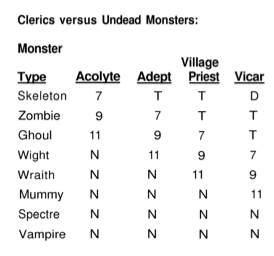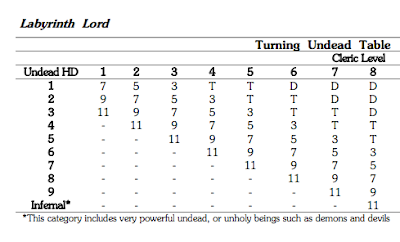 |
| Excerpt from Men & Magic page 22 |
To the right you can see an excerpt from the original turn undead system from OD&D. This basic idea has filtered down through all TSR editions, though it was finally replaced by the bland damage mechanic of Third Edition. The way this table works is really nice mechanically. As the cleric gets more powerful, more types of undead can be automatically turned or destroyed, but a random roll is still require to see if the more powerful undead are affected. As elegant as the results are, it still requires a table. Maybe we can approximate the table with a simple rule? It’s been done before, but here are some other approaches.
The original system works by having auto-turn (and auto-destroy) values based on cleric level, and then adding a bonus of 1 to 3 from a random roll. The percentages behind that random roll are:
- 2d6, 7+ = 58.22%
- 2d6, 9+ = 27.78%
- 2d6, 11+ = 8.33%
So, considering the max HD of the affected target, rolling 7+ gives you one extra HD, rolling 9+ gives you two extra HD, and rolling 11+ gives you three more HD (corresponding to skeleton, zombie, and ghoul on the first level of the turning table). Yes, the HD equivalent is not perfect, but these monsters also have some special abilities and immunities, so the equivalency is good enough for government work. Quantifying undead by HD is pretty much what all the clones do, also.
The traditional turing table works out to this:
- Max HD of undead turned = (level – 1) + bonus
- Max HD of enemy destroyed or banished = (level – 3) + bonus
There are several different ways to calculate the bonus. The most obvious and traditional method would be to use 2d6 as described above and remember that 7, 9, and 11 are the magic numbers (corresponding to +1, +2, and +3). One could also translate the equivalent percentages into d20 terms, as
Swords & Wizardry and Second Edition did. The idea I’m considering is making it a single d6 roll such that:
- 4 grants +1 HD
- 5 grants +2 HD
- 6 grants +3 HD
This dovetails nicely with some other mechanics that I am considering, but it does still require remembering 3 arbitrary numbers.
The level – 1 is also a bit inelegant (and an extra, if simple, math step in the common case). What if we allowed anyone (non-chaotic) to attempt turning undead, assuming they had a cross? That would be “zero level” turning, whereas classed characters would add their turning level to the roll. It would fit the literature (after all, characters other than Van Helsing can use holy symbols in Dracula, if I recall correctly). I’m not sure if that steps on the clerics toes too much or not. Given my general approach to thief abilities (anyone can try, thieves are just better), it seems reasonable. It would mean that “first level” turning ability would start at the Adept level. Just an idea. Or maybe (level – 1) is not that bad.
Also, the number of hit dice affected can just be Nd6 where N is the cleric level. I think that probably works better than any other way of counting how many undead are affected. In fact, if we wanted to go really simple, and still preserve the basic idea, we could replace the whole system with rolling for the number of HD affected, but also assume that the max HD of any creature turned is N + 2, and that undead of N – 3 HD are destroyed outright. That would mean a character with first level turning ability would be able to turn away 1d6 HD worth of undead, of up to 3 HD each. This could still easily lead to failures at first level even though you always successfully turn at least 1 HD. For example, you could roll a 1 or 2 against a group of multiple single-HD undead.
Assuming you wanted to get rid of the lookup table, which approach would you prefer? Or do you have an even better idea? Or am I a heretic for considering doing away with the table?
It’s notable that most of the clones have decreased the power of turn undead, requiring clerics to roll for weak undead, even as level increases (though with lower target numbers). For comparison, here are excerpts from the Swords & Wizardry WhiteBox and Labyrinth Lord turning tables, which don’t give any automatic results until 4th level:





I don’t mind using tables, as turning only happens in specific types of encounters (i.e. those involving undead) and so looking it up isn’t going to bog things down too much or too frequently. I never looked very closely at the LL tables, but I’m liking what I see here, and may adopt them for my B/X game.
If I were going to use a non-table system, I think the 1d6 HD per level makes the most sense and would be easiest to use.
When I examined the turn undead table, comparing undead hit dice to cleric level, I came to the conclusion that it’s really a reaction roll table in disguise, with 1st level cleric vs. 1 HD (OD&D) zombies as the standard, turning these on a 9+ (Good reaction.) If you treat half-HD skeletons as 0 HD, the cleric is 1 level higher, and gets a +2 to the roll (effective target number 7.)
So, the formula would be 2d6 + 2 x (cleric level – undead HD) must be 9+. Autoturn and autodestroy happen at specific LVL – HD points.
Now, if I were to use 1d6 instead, the target is 5+ and the bonus isn’t doubled, so 1st level clerics would get +1 vs. skeletons, -1 vs ghouls. With this method, a +2 means no roll is necessary, and a +4 means the undead is destroyed.
However, since you have to roll 2 dice for the number of undead turned or destroyed, I’d rather just not tell the player what the monster’s hit dice are, have them roll 2d6, and then either compare the modified result to 9+ or use the unmodifed result as the number turned or destroyed.
Good stuff. Treating the half-HD skeletons as 0 is a good way to get around the awkwardness of the (level – 1) result. I’m still on the fence about doing a calculation like “2d6 + 2 x (cleric level – undead HD) must be 9+” in my head. The Nd6 method seems pretty attractive, and it would also probably be easier to explain to a player (“roll Nd6, you will be affecting undead of up to N + 2 HD”) while preserving the same kind of results.
Whenever I’ve played a Cleric, I’ve just added a list of undead and my turning numbers to my character sheet. When I go up in level, I adjust hit points, spells, and turn numbers. Then I don’t have a table look up in play, I just look at my sheet.
But if you want to get rid of the charts and just have a formula, the Nd6 system you propose looks good in theory. I’m interested to see how it works in play.
Good point about just writing the numbers on the character sheet. That’s what I do with attack matrices too. Unstated in the post, but this is also in service of working the turing ability (called “banishment” for more general applicability) into a game which does not have any lookup tables.